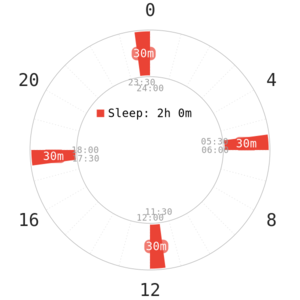Dymaxion
History
Dymaxion (often referred to as Dymax), is the first and original polyphasic schedule in the "-maxion" family. It was created by Buckminster Fuller, in the 1930s, who reportedly slept on this schedule for most of the time between 1932 and 1933. Dymaxion stands for ‘dynamic maximum tension’ and Fuller applied this word to many other inventions of his, including a house, a car, and a map. Fuller reported that "2 hours of sleep per day is plenty", which may insinuate at his sky-high motivation to live a life of an inventor who is willing to spend as little time on sleep as possible.
With Dymaxion being one of the most advanced polyphasic schedules that shape the definition, usage and legend of polyphasic sleep practice, together with Uberman, it also attracts several attempts over the course of decades. Recently, its formation also spurred the inspiration for 2 "-maxion" schedules (Bimaxion and Trimaxion) that take on the mantle of the original 30m naps in Dymaxion and posing as easier equivalents.
Dymaxion vs Uberman
Most things that apply to Uberman also apply to Dymaxion. Because it is a nap-only schedule with a total of 2h of sleep time, it has a lot of similarities to Uberman, including the extremely high difficulty, miniscule success rate, insane adaptation, and basically no flexibility. Like with Uberman all of the SWS and REM must come from naps on this schedule, so the amount of SWS and REM in proportion to light sleep is very high. Dymaxion still tends to be less popular than Uberman.
Difficulty-wise Dymaxion is harder than Uberman. Because of the larger gap between naps (5h30m compared to 3h40m) the wakefulness-sustaining capacity of naps is going to falter. The length of the naps is during adaptation, however, the hardest part of the schedule.
SWS will usually begin at around the 25 minute mark even when the SWS pressure is low. After the first day or two every nap is going to end in SWS because the nap is long enough to cross this SWS boundary. In contrast to this, with a 20 minute nap-only schedule like Uberman the naps will contain SWS only after the SWS pressure hits a peak or when the sleep cycle is compressed enough that the naps are able to have the SWS start earlier. This means that nap-only schedules with 20m naps don’t get SWS wakes until some time has passed on the schedule.
Even in the beginning of adaptation the naps on Dymaxion are harder to wake from than the naps on Uberman, because they all have SWS wakes. SWS wakes are associated with grogginess after wake up (sleep inertia), so waking up from every nap is going to be difficult until the body gets used to the nap length and performs wake time programming. They are also associated with a difficulty of hearing alarms, which means that even those with a high willpower are going to have a really hard time actually waking up from the naps. Finally, in SWS wakes you are very prone to immediately falling back asleep unless you stand up. Naps that end in SWS also have the disadvantage of forgetting or not having dreams when you wake up.
Adaptation
Currently there are 2 methods to adapt to Dymaxion. Each of them has pros and cons, but successful adaptations remain very rare.

